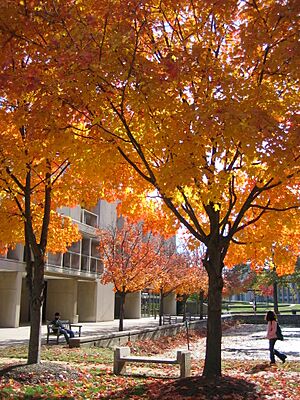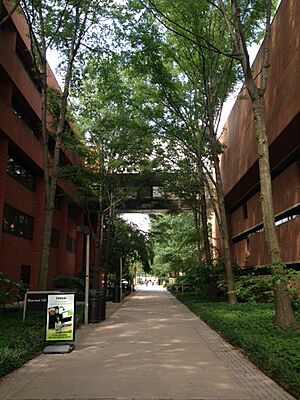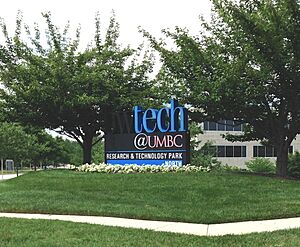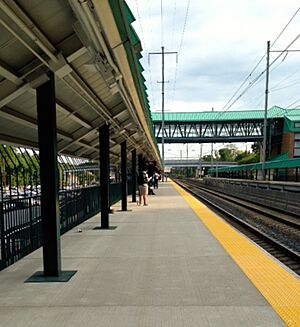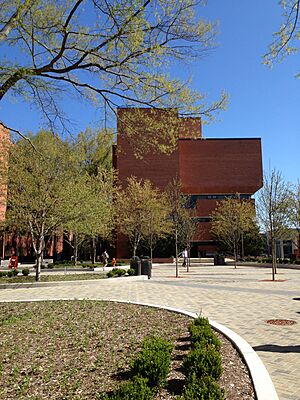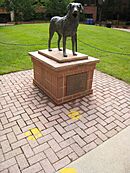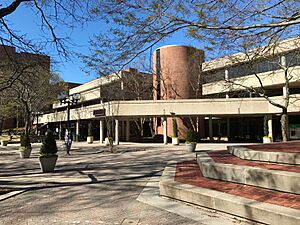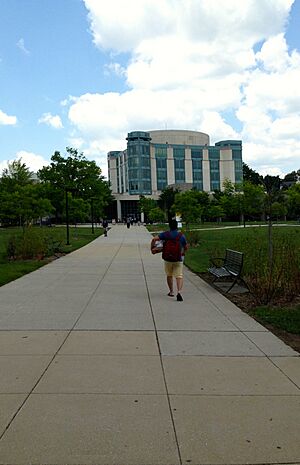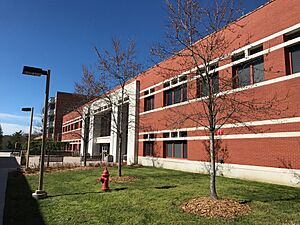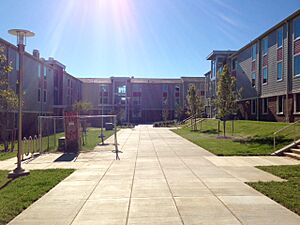University of Maryland, Baltimore County facts for kids
 |
|
| Motto | An Honors University in Maryland |
|---|---|
| Type | Public research university |
| Established | 1966 |
|
Parent institution
|
University System of Maryland |
|
Academic affiliations
|
|
| Endowment | $167.1 million (2024) |
| Budget | $691.1 million (2025) |
| President | Valerie Sheares Ashby |
| Provost | Manfred H. M. van Dulmen |
|
Academic staff
|
Full-Time: 569 Part-Time: 380 |
|
Administrative staff
|
1,288 |
| Students | 14,148 (Fall 2023) |
| Undergraduates | 10,490 |
| Postgraduates | 3,658 |
| Location |
,
,
United States
39°15′19.80″N 76°42′40.52″W / 39.2555000°N 76.7112556°W |
| Campus | Suburban, 500 acres (2.0 km2) |
| Colors | Black, Gold, Red, White |
| Nickname | Retrievers |
|
Sporting affiliations
|
NCAA Division I America East Conference |
| Mascot | True Grit the Retriever |
 |
|
The University of Maryland, Baltimore County (UMBC) is a public research university. It is located in Catonsville, Maryland, in the United States. The university is named after Baltimore County.
In Fall 2022, UMBC had nearly 14,000 students. It offers many different study programs. These include 61 undergraduate majors and over 90 graduate programs. UMBC is known for its strong research activities. It was the first university in Maryland to have a research park.
UMBC was started in 1966. It was part of the University System of Maryland. It was also the first public college in Maryland to welcome students of all races. UMBC is one of the largest universities in the system. It is especially strong in science, engineering, and liberal arts. Its sports teams are called the UMBC Retrievers. They compete in the America East Conference.
Contents
History of UMBC
Discussions about creating UMBC began in the 1950s. This was because many more students wanted to go to college after World War II. Also, the population and industries in the Baltimore-Washington area were growing fast. At that time, the University of Maryland, College Park was the main university. People wanted to add a new campus in the Baltimore area.
In 1963, the Maryland Legislature approved new universities. By the end of that year, 435 acres of land were bought. This land came from Spring Grove State Hospital in Catonsville, Maryland. The new campus was in a good spot. It was easy to reach from major roads.
The first classes at UMBC started on September 19, 1966. There were 750 students and 45 teachers. The university grew quickly. It also saw many changes in society during the 1960s. UMBC became known as a place for open minds.
By 1980, UMBC had 5,800 undergraduate students. New buildings like the University Center were opened. Famous puppeteer Jim Henson helped fund a research center at UMBC. In 1992, Freeman A. Hrabowski III became president. He led the university for 30 years.
In the early 2000s, UMBC continued to grow. New centers were created, like one for environmental research. The university also partnered with NASA. UMBC was recognized for its strong science programs. It became known as a top research university.
Academics and Research
UMBC offers many different degree programs. Students can choose from 61 majors and 70 minors. There are also many graduate programs. The university is organized into colleges and schools.
Colleges at UMBC
- The UMBC College of Natural and Mathematical Sciences focuses on science and math. It includes departments like Biology, Chemistry, and Physics.
- The UMBC College of Engineering and Information Technology offers studies in engineering and computer science. This includes Chemical Engineering and Information Systems.
- The UMBC College of Arts, Humanities and Social Sciences has the most departments. It offers degrees in subjects like History, Dance, Music, and Psychology. Many of these are in the new Performing Arts and Humanities Building.
Schools at UMBC
- The UMBC Erickson School of Aging Studies teaches about different parts of aging.
- The University of Maryland Graduate School, Baltimore (UMGSB) combines graduate programs from UMBC and the University of Maryland, Baltimore.
- The UMBC School of Public Policy offers master's and doctorate degrees in public policy.
- The University of Maryland, Baltimore School of Social Work works with UMBC. They offer social work programs.
Research and Discoveries
UMBC is one of the fastest-growing research universities. It is known for having very high research activity. The university often ranks high in federal research funding. UMBC's research focuses on many areas. These include environmental science, health, and data science. They also study cybersecurity and artificial intelligence.
UMBC is among the top U.S. universities for NASA funding. Its NASA-funded centers work with the Goddard Space Flight Center. They research Earth systems, planets, and space science.
Many UMBC teachers have won important awards for their research. The university's research park, bwtech@UMBC, helps over 130 companies. It has special areas for cybersecurity and life sciences. UMBC also has more than 20 research centers. These include centers for sensor technology, environmental research, and artificial intelligence.
Campus Life and Features
UMBC's campus is located on 500 acres. It is about 15 minutes from Baltimore's Inner Harbor. It is also about an hour from Washington, D.C. The Baltimore-Washington International Airport is only 10 minutes away.
Campus History
The land where UMBC stands was bought by Maryland in 1840. It was once a large estate. Later, it became part of Spring Grove State Hospital. Some old buildings were used by UMBC at first. The Hillcrest Building was used for administration. It was torn down in 2007. The farm silo on UMBC Boulevard is now the oldest building on campus.
UMBC was created in 1966 to help with the large number of students. It was a new kind of campus. It has grown into a national example for new universities.
Campus Layout
The main entrance to UMBC is from Metropolitan Boulevard. The campus is also served by Wilkens Avenue. This road connects to the Baltimore Beltway.
Academic Row is a main walking path through campus. It is lined with trees and buildings. These include the Administration Building and the Library. The path ends at the Albin O. Kuhn Library & Gallery.
The Commons is the university's student union. It is a popular spot for students. The Quad is a large grassy area near the Commons. Many student events happen there. The University Center also has dining options and event spaces.
Campus Location
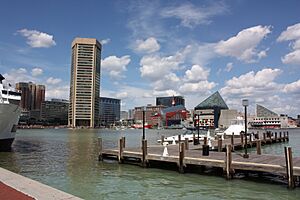
UMBC is located in Catonsville, Maryland. It is about 1.5 miles from Catonsville's main area. Catonsville offers a "college town" feel. It has restaurants and shops.
UMBC also offers some programs at Universities at Shady Grove. This is a campus in Rockville, Maryland.
Research and Technology Park
The UMBC Research and Technology Park is a 71-acre area. It hosts many technology and research companies. Many of these companies work with the university. It is the oldest university research park in Maryland. The North Campus focuses on cybersecurity. The South Campus helps new life science businesses grow.
Getting Around Campus
UMBC has several free bus shuttle lines for students and staff. These buses connect the campus to downtown Baltimore. They also link to the Baltimore Metro Subway and MARC Train.
The Maryland Transit Administration also has bus lines that serve UMBC. The MARC Train provides service two miles from campus at Halethorpe station. This connects the university to Baltimore and Washington.
The campus also has paths for walking and biking. These paths connect different parts of campus. They also link to nearby trails.
University President
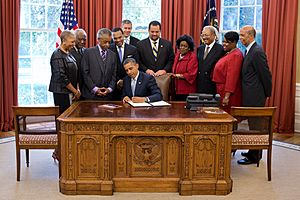
Freeman A. Hrabowski III was president of UMBC from 1992 until 2022. He was recognized as one of the "100 Most Influential People in the World" by TIME Magazine. Under his leadership, UMBC was often ranked as a top "Up and Coming University."
On August 1, 2022, Valerie Sheares Ashby became the new president. She is the first female president of the university.
University Rankings
| THES World | 601-800 |
|---|---|
| USNWR National University | 144 |
| Washington Monthly National University | 193 |
| Forbes | 74 |
| Subject | Rank |
|---|---|
| Biological Sciences | 140 |
| Chemistry | 81 |
| Clinical Psychology | 74 |
| Computer Science | 82 |
| Engineering | 90 |
| Fine Arts | 89 |
| Mathematics | 117 |
| Physics | 91 |
| Psychology | 98 |
| Public Affairs | 82 |
| Statistics | 69 |
In 2025, U.S. News & World Report ranked UMBC tied for 144th among "National Universities." It was also ranked 74th nationally among public universities. UMBC was ranked 15th for undergraduate teaching. It was also 14th for innovation. UMBC is known as a research university with very high research activity.
Partnerships
UMBC works with many organizations. It has a partnership with NASA. Its centers work with the Goddard Space Flight Center. They share research efforts with the University of Maryland, College Park.
In 2014, UMBC signed agreements with the United States Army Research Laboratory. They work together on research in computer science, cybersecurity, and robotics.
UMBC and the University of Maryland, Baltimore (UMB) also work together. They have a program that gives grants for research. This helps students and teachers from both universities.
In 2015, UMBC partnered with Kyushu University in Japan. They work together on computer security research. UMBC also announced partnerships with the US Navy. This included opening the first Naval ROTC unit in Maryland at UMBC.
Sustainability Efforts
In 1997, President Freeman Hrabowski created the Conservation and Environmental Research Areas of UMBC (CERA). This area covers 50 acres on the south end of campus. CERA helps preserve the land. It also allows students to use the land for learning and recreation.
UMBC is committed to being environmentally friendly. The university uses renewable energy. New buildings are designed to be energy efficient. They have also added "no-mow zones" and ponds to manage stormwater.
In 2013, UMBC was recognized as a Tree Campus USA. In 2014, UMBC set aside 11 acres for preservation. The university also opened its first community garden for students. This lets students grow their own food on campus.
Students have also started projects to help the environment. "Retriever Treasure" collects unwanted items from students. They resell them to raise money for other green projects. "SolarRetrievers" added solar tables to campus. These tables show how solar power can charge devices.
Mascot
The Chesapeake Bay Retriever is the state dog of Maryland. It has been UMBC's mascot since 1966. The costumed mascot is named "True Grit." The university also had a live mascot named Campus Sam. Later, a new puppy mascot was chosen and named "Gritty." The school's dining hall is called True Grits.
Student Life
| Race and ethnicity | Total | ||
|---|---|---|---|
| White | 31% |
|
|
| Asian | 24% |
|
|
| Black | 24% |
|
|
| Hispanic | 9% |
|
|
| Other | 6% |
|
|
| Foreign national | 5% |
|
|
| Economic diversity | |||
| Low-income | 30% |
|
|
| Affluent | 70% |
|
|
UMBC has over 220 student-run organizations. These groups offer many activities and events.
Student Events
UMBC holds a Homecoming event in the fall. It includes a 5K race and a comedy show. Famous comedians like Trevor Noah and Jim Gaffigan have performed.
Quadmania is a student festival in the spring. It takes place outdoors on campus. Past performers include Gym Class Heroes, Macklemore & Ryan Lewis, and Kesha.
Greek Life
UMBC has 20 sororities and fraternities. About 5% of undergraduate students are part of these groups.
Mock Trial Team
UMBC has a strong undergraduate mock trial team. In 2021, UMBC won the American Mock Trial Association (AMTA) National Championship. They beat Yale University in a very close final round. This was a big achievement for the team.
Campus Housing
UMBC has ten housing areas. About 3,900 students live on campus. These include residence halls like Potomac Hall and Chesapeake Hall. There are also apartment-style dorms.
Many students also live off campus. About 65% of all students live in nearby communities. These include Catonsville and Arbutus. UMBC Transit bus lines serve many of these neighborhoods.
Chess Program

UMBC has a very successful chess program. The team has won the Pan American Chess Tournament nine times. They offer scholarships to talented high school chess players. Former UMBC team captain GM Alexander Onischuk became a US Champion.
Athletics
The UMBC sports teams are called the Retrievers. They compete in NCAA Division I. They are part of the America East Conference.
UMBC has 17 varsity sports. These include baseball, basketball, lacrosse, and soccer.
Sports Achievements
In 2009, the men's lacrosse team won their conference championship. They have also played in the NCAA tournament several times. In 2007, they upset Maryland in the NCAA tournament.
In 2016, UMBC spent $67 million on a new event center. This center opened in 2018. It hosts basketball games and concerts.
A famous moment happened on March 16, 2018. The Retrievers’ Men's Basketball team made history. They became the first No. 16 seed to beat a No. 1 seed in the NCAA men's basketball tournament. They defeated the Virginia Cavaliers 74–54. They then moved on to the next round for the first time ever.
Soccer Success
The UMBC men's soccer team has also had great success. They were the first team in tournament history to win four road games in a row. They also had four shutouts in a row.
The UMBC Women's Soccer Team won their first American East Conference title in 2013. They then made their first NCAA tournament appearance.
Notable People
Images for kids


